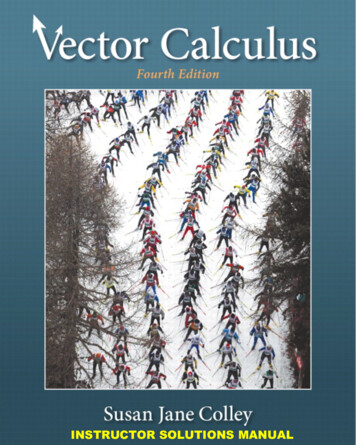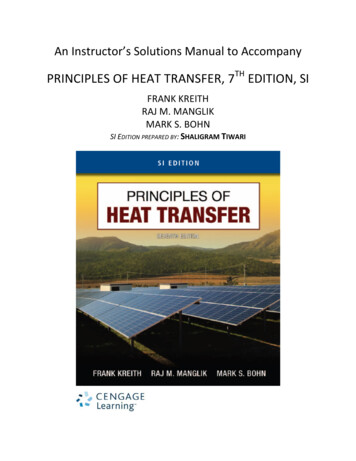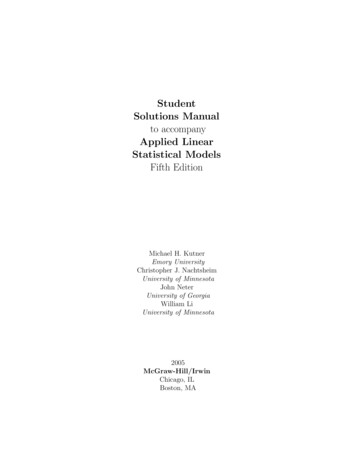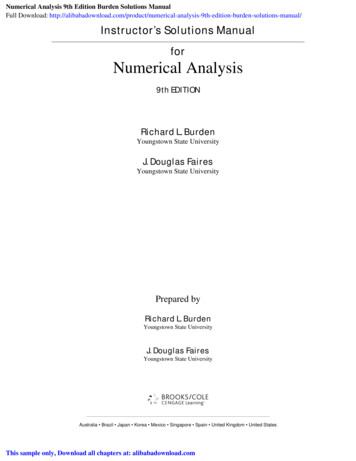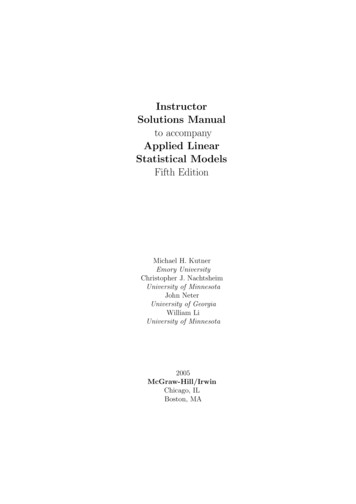
Transcription
InstructorSolutions Manualto accompanyApplied LinearStatistical ModelsFifth EditionMichael H. KutnerEmory UniversityChristopher J. NachtsheimUniversity of MinnesotaJohn NeterUniversity of GeorgiaWilliam LiUniversity of Minnesota2005McGraw-Hill/IrwinChicago, ILBoston, MA
PREFACEThis Solutions Manual gives intermediate and final numerical results for all end-of-chapterProblems, Exercises, and Projects with computational elements contained in Applied LinearStatistical M odels, 5th edition. This Solutions Manual also contains proofs for all Exercisesthat require derivations. No solutions are provided for the Case Studies.In presenting calculational results we frequently show, for ease in checking, more digitsthan are significant for the original data. Students and other users may obtain slightlydifferent answers than those presented here, because of different rounding procedures. Whena problem requires a percentile (e.g. of the t or F distributions) not included in the AppendixB Tables, users may either interpolate in the table or employ an available computer programfor finding the needed value. Again, slightly different values may be obtained than the onesshown here.We have included many more Problems, Exercises, and Projects at the ends of chaptersthan can be used in a term, in order to provide choice and flexibility to instructors in assigningproblem material. For all major topics, three or more problem settings are presented, and theinstructor can select different ones from term to term. Another option is to supply studentswith a computer printout for one of the problem settings for study and class discussion and toselect one or more of the other problem settings for individual computation and solution. Bydrawing on the basic numerical results in this Manual, the instructor also can easily designadditional questions to supplement those given in the text for a given problem setting.The data sets for all Problems, Exercises, Projects and Case Studies are contained in thecompact disk provided with the text to facilitate data entry. It is expected that the studentwill use a computer or have access to computer output for all but the simplest data sets,where use of a basic calculator would be adequate. For most students, hands-on experiencein obtaining the computations by computer will be an important part of the educationalexperience in the course.While we have checked the solutions very carefully, it is possible that some errors arestill present. We would be most grateful to have any errors called to our attention. Erratacan be reported via the website for the book: http://www.mhhe.com/KutnerALSM5e. Weacknowledge with thanks the assistance of Lexin Li and Yingwen Dong in the checking ofChapters 1-14 of this manual. We, of course, are responsible for any errors or omissions thatremain.Michael H. KutnerChristopher J. NachtsheimJohn NeterWilliam Lii
ii
Contents1 LINEAR REGRESSION WITH ONE PREDICTOR VARIABLE1-12 INFERENCES IN REGRESSION AND CORRELATION ANALYSIS2-13 DIAGNOSTICS AND REMEDIAL MEASURES3-14 SIMULTANEOUS INFERENCES AND OTHER TOPICS IN REGRESSION ANALYSIS4-15 MATRIX APPROACH TO SIMPLE LINEAR REGRESSION ANALYSIS5-16 MULTIPLE REGRESSION – I6-17 MULTIPLE REGRESSION – II7-18 MODELS FOR QUANTITATIVE AND QUALITATIVE PREDICTORS 8-19 BUILDING THE REGRESSION MODEL I: MODEL SELECTION ANDVALIDATION9-110 BUILDING THE REGRESSION MODEL II: DIAGNOSTICS10-111 BUILDING THE REGRESSION MODEL III: REMEDIAL MEASURES11-112 AUTOCORRELATION IN TIME SERIES DATA12-113 INTRODUCTION TO NONLINEAR REGRESSION AND NEURAL NETWORKS13-114 LOGISTIC REGRESSION, POISSON REGRESSION,AND GENERALIZED LINEAR MODELS14-115 INTRODUCTION TO THE DESIGN OF EXPERIMENTAL AND OBSERVATIONAL STUDIES15-116 SINGLE-FACTOR STUDIES16-117 ANALYSIS OF FACTOR LEVEL MEANS17-1iii
18 ANOVA DIAGNOSTICS AND REMEDIAL MEASURES18-119 TWO-FACTOR ANALYSIS OF VARIANCE WITH EQUAL SAMPLESIZES19-120 TWO-FACTOR STUDIES – ONE CASE PER TREATMENT20-121 RANDOMIZED COMPLETE BLOCK DESIGNS21-122 ANALYSIS OF COVARIANCE22-123 TWO-FACTOR STUDIES WITH UNEQUAL SAMPLE SIZES23-124 MULTIFACTOR STUDIES24-125 RANDOM AND MIXED EFFECTS MODELS25-126 NESTED DESIGNS, SUBSAMPLING, AND PARTIALLY NESTED DESIGNS26-127 REPEATED MEASURES AND RELATED DESIGNS27-128 BALANCED INCOMPLETE BLOCK, LATIN SQUARE, AND RELATEDDESIGNS28-129 EXPLORATORY EXPERIMENTS – TWO-LEVEL FACTORIAL ANDFRACTIONAL FACTORIAL DESIGNS29-130 RESPONSE SURFACE METHODOLOGY30-1Appendix D: RULES FOR DEVELOPING ANOVA MODELS AND TABLESFOR BALANCED DESIGNSD.1iv
Chapter 1LINEAR REGRESSION WITH ONEPREDICTOR VARIABLE1.1.No1.2.Y 300 2X, functional1.5.No1.7.a.Nob.Yes, .681.8.Yes, no1.10. No1.12. a. Observational1.13. a. Observational1.18. No1.19. a.β0 2.11405, β1 0.03883, Ŷ 2.11405 .03883Xc.Ŷh 3.27895d.β1 0.038831.20. a.d.1.21. a.Ŷ 0.5802 15.0352XŶh 74.5958Ŷ 10.20 4.00Xb.Ŷh 14.2c.4.0d.(X̄, Ȳ ) (1, 14.2)1.22. a.Ŷ 168.600000 2.034375X1-1
b.Ŷh 249.975c.β1 2.0343751.23. a.i:1ei : 0.96762.1.2274 . . .Yesb.1.24. a.M SE 0.388, 119-0.8753120-0.2532M SE 0.623, grade pointsi:12.ei : -9.4903 0.4392 . . .441.4392452.4039P 2ei 3416.377P 2Min Q b.1.25. a.b.eiM SE 79.45063, M SE 8.913508, minutese1 1.8000P 2ei 17.6000, M SE 2.2000, σ 21.26. a.i:1ei : -2.150234563.850 -5.150 -1.150 .575 2.575i:7ei : -2.425895.575 3.300i: 13ei : .0251415-1.975 3.025Yesb.1.27. a.b.M SE 10.459, 1011.300 1.30012-3.70016-3.975M SE 3.234, Brinell unitsŶ 156.35 1.19X(1) b1 1.19, (2) Ŷh 84.95, (3) e8 4.4433,(4) M SE 66.81.28. a.b.Ŷ 20517.6 170.575X(1) b1 170.575, (2) Ŷh 6871.6, (3) e10 1401.566,(4) M SE 55521121.31. No, no1.32. Solving (1.9a) and (1.9b) for b0 and equating the results:PYi b1nPXiP 1-2X i Yi b 1PXiPXi2
and then solving for b1 yields:b1 1.33. Q nPPXi Yi Xi Yi Pn Xi2 ( Xi )2PPPX i YiX i Yi P n( Xi )2P 2Xi nPPP(Yi β0 )2XdQ 2 (Yi β0 )dβ0Setting the derivative equal to zero, simplifying, and substituting the least squaresestimator b0 yields:P(Yi b0 ) 0 or b0 Ȳ1.34. E{b0 } E{Ȳ } 1X1XE{Yi } β0 β0nn1.35. From the first normal equation (1.9a):P1.36.Yi nb0 b1PXi P(b0 b1 Xi ) PŶi from (1.13)PPPPPŶ e (b0 b1 Xi )ei b0 ei b1 Xi ei 0 because ei 0 from (1.17) andP i iXi ei 0 from (1.19).1.38. (1) 76, yes; (2) 60, yes1.39. a.Applying (1.10a) and (1.10b) to (5, Ȳ1 ), (10, Ȳ2 ) and (15, Ȳ3 ), weobtain:Ȳ3 Ȳ14Ȳ1 Ȳ2 2Ȳ3b0 103Using (1.10a) and (1.10b) with the six original points yields the same results.b1 b.Yes1.40. No1.41. a.PQ (Yi β1 Xi )2XdQ 2 (Yi β1 Xi )Xidβ1Setting the derivative equal to zero, simplifying, and substituting the least squaresestimator b1 yields:PYi Xib1 P 2Xib.L ·11exp 2 (Yi β1 Xi )221/22σi 1 (2πσ )nQ1-3
It is more convenient to work with loge L :n1 Xloge L loge (2πσ 2 ) 2(Yi β1 Xi )222σd loge L1 X (Yi β1 Xi )Xidβ1σ2c.1.42. a.b.Setting the derivative equal to zero, simplifying, and substituting the maximumlikelihood estimator b1 yields:PYi XiP(Yi b1 Xi )Xi 0 or b1 P 2XiYes(P)Yi Xi1 XE{b1 } E P 2 P 2Xi E{Yi }XiXi1 X P 2Xi (β1 Xi ) β1Xi11exp[ (Yi β1 Xi )2 ]32i 132π 30L(17) 9.45 10 , L(18) 2.65 10 7 , L(19) 3.05 10 37L(β1 ) 6Q β1 18c.b1 17.928, yesd.Yes1.43. a.Total population: Ŷ 110.635 0.0027954XNumber of hospital beds: Ŷ 95.9322 0.743116XTotal personal income: Ŷ 48.3948 .131701Xc.Total population: M SE 372, 203.5Number of hospital beds: M SE 310, 191.9Total personal income: M SE 324, 539.41.44. a.Region 1: Ŷ 1723.0 480.0XRegion 2: Ŷ 916.4 299.3XRegion 3: Ŷ 401.56 272.22XRegion 4: Ŷ 396.1 508.0Xc.Region 1: M SE 64, 444, 465Region 2: M SE 141, 479, 673Region 3: M SE 50, 242, 464Region 4: M SE 514, 289, 3671.45. a.Infection risk: Ŷ 6.3368 .7604XFacilities: Ŷ 7.7188 .0447X1-4
X-ray: Ŷ 6.5664 .0378Xc.Infection risk: M SE 2.638Facilities: M SE 3.221X-ray: M SE 3.1471.46. a.Region 1: Ŷ 4.5379 1.3478XRegion 2: Ŷ 7.5605 .4832XRegion 3: Ŷ 7.1293 .5251XRegion 4: Ŷ 8.0381 .0173Xc.Region 1: M SE 4.353Region 2: M SE 1.038Region 3: M SE .940Region 4: M SE 1.078b.11exp[ (Yi β0 β1 Xi )2 ]32i 132πb0 1.5969, b1 17.8524c.Yes1.47. a.L(β0 , β1 ) 6Q 1-5
1-6
Chapter 2INFERENCES IN REGRESSIONAND CORRELATION ANALYSIS2.1.a. Yes, α .052.2.No2.4.a.t(.995; 118) 2.61814, .03883 2.61814(.01277), .00540 β1 .07226b.H0 : β1 0, Ha : β1 6 0. t (.03883 0)/.01277 3.04072. If t 2.61814,conclude H0 , otherwise Ha . Conclude Ha .c.0.00291a.t(.95; 43) 1.6811, 15.0352 1.6811(.4831), 14.2231 β1 15.8473b.H0 : β1 0, Ha : β1 6 0. t (15.0352 0)/.4831 31.122. If t 1.681conclude H0 , otherwise Ha . Conclude Ha . P -value 0 c.Yesd.H0 : β1 14, Ha : β1 14. t (15.0352 14)/.4831 2.1428. If t 1.681conclude H0 , otherwise Ha . Conclude Ha . P -value .0189a.t(.975; 8) 2.306, b1 4.0, s{b1 } .469, 4.0 2.306(.469),2.5.2.6.2.918 β1 5.082b.H0 : β1 0, Ha : β1 6 0. t (4.0 0)/.469 8.529. If t 2.306 conclude H0 ,otherwise Ha . Conclude Ha . P -value .00003c.b0 10.20, s{b0 } .663, 10.20 2.306(.663), 8.671 β0 11.729d.H0 : β0 9, Ha : β0 9. t (10.20 9)/.663 1.810. If t 2.306 conclude H0 ,otherwise Ha . Conclude H0 . P -value .053e.H0 : β1 0: δ 2 0 /.5 4, power .93H0 : β0 9: δ 11 9 /.75 2.67, power .782.7.a.t(.995; 14) 2.977, b1 2.0344, s{b1 } .0904, 2.0344 2.977(.0904),1.765 β1 2.3042-1
2.8.b.H0 : β1 2, Ha : β1 6 2. t (2.0344 2)/.0904 .381. If t 2.977 concludeH0 , otherwise Ha . Conclude H0 . P -value .71c.δ .3 /.1 3, power .50a.H0 : β1 3.0, Ha : β1 6 3.0. t (3.57 3.0)/.3470 1.643,t(.975; 23) 2.069. If t 2.069 conclude H0 , otherwise Ha . Conclude H0 .b.2.10. a.δ .5 /.35 1.43, power .30 (by linear interpolation)Predictionb.Mean responsec.Prediction2.12. No, no2.13. a.Ŷh 3.2012, s{Ŷh } .0706, t(.975; 118) 1.9803, 3.2012 1.9803(.0706),3.0614 E{Yh } 3.3410b.s{pred} .6271, 3.2012 1.9803(.6271), 1.9594 Yh( new) 4.4430c.Yes, yesd.W 2 2F (.95; 2, 118) 2(3.0731) 6.1462, W 2.4792, 3.2012 2.4792(.0706),3.0262 β0 β1 Xh 3.3762, yes, yes2.14. a.Ŷh 89.6313, s{Ŷh } 1.3964, t(.95; 43) 1.6811, 89.6313 1.6811(1.3964),87.2838 E{Yh } 91.9788b.s{pred} 9.0222, 89.6313 1.6811(9.0222), 74.4641 Yh(new) 104.7985, yes,yesc.87.2838/6 14.5473, 91.9788/6 15.3298, 14.5473 Mean time per machine 15.3298d.W 2 2F (.90; 2, 43) 2(2.4304) 4.8608, W 2.2047, 89.6313 2.2047(1.3964),86.5527 β0 β1 Xh 92.7099, yes, yes2.15. a.Xh 2: Ŷh 18.2, s{Ŷh } .663, t(.995; 8) 3.355, 18.2 3.355(.663), 15.976 E{Yh } 20.424Xh 4: Ŷh 26.2, s{Ŷh } 1.483, 26.2 3.355(1.483), 21.225 E{Yh } 31.175b.s{pred} 1.625, 18.2 3.355(1.625), 12.748 Yh(new) 23.652c.s{predmean} 1.083, 18.2 3.355(1.083), 14.567 Ȳh(new) 21.833, 44 3(14.567) Total number of broken ampules 3(21.833) 65d.W 2 2F (.99; 2, 8) 2(8.649) 17.298, W 4.159Xh 2: 18.2 4.159(.663), 15.443 β0 β1 Xh 20.957Xh 4: 26.2 4.159(1.483), 20.032 β0 β1 Xh 32.368yes, yes2.16. a.Ŷh 229.631, s{Ŷh } .8285, t(.99; 14) 2.624, 229.631 2.624(.8285), 227.457 E{Yh } 231.8052-2
b.s{pred} 3.338, 229.631 2.624(3.338), 220.872 Yh(new) 238.390c.s{predmean} 1.316, 229.631 2.624(1.316), 226.178 Ȳh(new) 233.084d.Yes, yese.W 2 2F (.98; 2, 14) 2(5.241) 10.482, W 3.238, 229.631 3.238(.8285),226.948 β0 β1 Xh 232.314, yes, yes2.17. Greater, H0 : β1 02.20. No2.21. No2.22. Yes, yes2.23. a.SourceSSdfRegression 3.587851Error45.8176 118Total49.40545 119MS3.587850.388285Pb.σ 2 β12(Xi X̄)2 , σ 2 , when β1 0c.H0 : β1 0, Ha : β1 6 0. F 3.58785/0.388285 9.24, F (.99; 1, 118) 6.855. IfF 6.855 conclude H0 , otherwise Ha . Conclude Ha .d.SSR 3.58785, 7.26% or 0.0726, coefficient of determinatione. 0.2695f.R22.24. a.SourceRegressionErrorTotalSSdfMS76,960.4 1 76,960.43,416.38 43 79.450680,376.78 44SourceSSdfMSRegression76,960.4 1 76,960.4Error3,416.38 43 79.4506Total80,376.78 44Correction for mean 261,747.2 1Total, uncorrected342,124 45b.H0 : β1 0, Ha : β1 6 0. F 76, 960.4/79.4506 968.66, F (.90; 1, 43) 2.826.If F 2.826 conclude H0 , otherwise Ha . Conclude Ha .c.95.75% or 0.9575, coefficient of determinationd. .9785e.R22-3
2.25. 89MS160.002.20b.H0 : β1 0, Ha : β1 6 0. F 160.00/2.20 72.727, F (.95; 1, 8) 5.32. IfF 5.32 conclude H0 , otherwise Ha . Conclude Ha .c.t (4.00 0)/.469 8.529, (t )2 (8.529)2 72.7 F d.R2 .9009, r .9492, 90.09%2.26. a.SourceSSRegression ,297.512510.4589H0 : β1 0, Ha : β1 6 0, F 5, 297.5125/10.4589 506.51, F (.99; 1, 14) 8.86.If F 8.86 conclude H0 , otherwise Ha . Conclude Ha .c.d.2.27. a.i:Yi Ŷi :Ŷi Ȳ :1-2.150-24.412523.850-24.4125i:Yi Ŷi :Ŷi Ȳ :7-2.425-8.1375i:Yi Ŷi :Ŷi Ȳ :1314.025-1.97524.4125 125 -24.4125 -8.1375 -8.13759103.300.3008.1375 .4125 24.4125R2 .9731, r .9865H0 : β1 0, Ha : β1 0. s{b1 } 0.090197,t ( 1.19 0)/.090197 13.193, t(.05; 58) 1.67155.If t 1.67155 conclude H0 , otherwise Ha . Conclude Ha .P -value 0 c.2.28. a.t(.975; 58) 2.00172, 1.19 2.00172(.090197), 1.3705 β1 1.0095Ŷh 84.9468, s{Ŷh } 1.05515, t(.975; 58) 2.00172,84.9468 2.00172(1.05515), 82.835 E{Yh } 87.059b.s{Yh(new) } 8.24101, 84.9468 2.00172(8.24101), 68.451 Yh(new) 101.443c.W 2 2F (.95; 2, 58) 2(3.15593) 6.31186, W 2.512342,84.9468 2.512342(1.05515), 82.296 β0 β1 Xh 87.598, yes, yes2.29. a.2-4
i:1Yi Ŷi : 0.823243Ŷi Ȳ : 20.21012.-1.55675 . . .22.5901 . . ression 11,627.5Error3,874.45Total15,501.95dfMS1 11,627.558 66.800859c.H0 : β1 0, Ha : β1 6 0. F 11, 627.5/66.8008 174.0623,F (.90; 1, 58) 2.79409. If F 2.79409 conclude H0 , otherwise Ha . ConcludeHa .d.24.993% or .24993e.R2 0.750067, r 0.8660642.30. a.H0 : β1 0, Ha : β1 6 0. s{b1 } 41.5743,t ( 170.575 0)/41.5743 4.1029, t(.995; 82) 2.63712.If t 2.63712 conclude H0 , otherwise Ha . Conclude Ha .P -value 0.000096b. 170.575 2.63712(41.5743), 280.2114 β1 60.93862.31. a.SourceSSRegression 93,462,942Error455,273,165Total548,736,107dfMS1 93,462,94282 5,552,11283b.H0 : β1 0, Ha : β1 6 0. F 93, 462, 942/5, 552, 112 16.8338, F (.99; 1, 82) 6.9544. If F 6.9544 conclude H0 , otherwise Ha. Conclude Ha . (t )2 ( 4.102895)2 16.8338 F . [t(.995; 82)]2 (2.63712)2 6.9544 F (.99; 1, 82).Yes.c.SSR 93, 462, 942, 17.03% or 0.1703d.-0.41272.32. a.Full: Yi β0 β1 Xi εi , reduced: Yi β0 εib. (1) SSE(F ) 455, 273, 165, (2) SSE(R) 548, 736, 107,(3) dfF 82, (4) dfR 83,(5) F [(548, 736, 107 455, 273, 165)/1] [455, 273, 165/82] 16.83376, (6) IfF F (.99; 1, 82) 6.95442 conclude H0 , otherwise Ha .c.2.33. a.YesH0 : β0 7.5, Ha : β0 6 7.5b.Full: Yi β0 β1 Xi εi , reduced: Yi 7.5 β1 Xi εic.Yes, dfR dfF (n 1) (n 2) 12-5
2.36Regression model2.38. No2.39. a.Normal, mean µ1 50, standard deviation σ1 3b.Normal, mean E{Y2 Y1 55} 105.33, standard deviation σ2 1 2.40c.Normal, mean E{Y1 Y2 95} 47, standard deviation σ1 2 1.802.40. (1) No, (2) no, (3) yes2.41. No2.42. b.95285, ρ12c.q H0 : ρ12 0, Ha : ρ12 6 0. t (.95285 13)/ 1 (.95285)2 11.32194,t(.995; 13) 3.012. If t 3.012 conclude H0 , otherwise Ha . Conclude Ha .d.No2.43. a.q H0 : ρ12 0, Ha : ρ12 6 0. t (.61 82)/ 1 (.61)2 6.9709,t(.975; 82) 1.993. If t 1.993 conclude H0 , otherwise Ha . Conclude Ha .b.z 0 .70892, σ{z 0 } .1111, z(.975) 1.960, .70892 1.960(.1111), .49116 ζ .92668, .455 ρ12 .729c.207 ρ212 .5312.44. a.q H0 : ρ12 0, Ha : ρ12 6 0. t (.87 101)/ 1 (.87)2 17.73321, t(.95; 101) 1.663. If t 1.663 conclude H0 , otherwise Ha . Conclude Ha .b.z 0 1.33308, σ{z 0 } .1, z(.95) 1.645, 1.33308 1.645(.1), 1.16858 ζ 1.49758, .824 ρ12 .905c.679 ρ212 .8192.45. a.z 0 1.18814, σ{z 0 } .0833, z(.995) 2.576, 1.18814 2.576(.0833),.97356 ζ 1.40272, .750 ρ12 .886.b.2.46. a.b.2.47. a.b.563 ρ212 .7850.9454874H0 : There is no association between Y1 and Y2Ha : There is an associationbetween Y1 and Y2 0.945487413 10.46803. t(0.995, 13) 3.012276. If t 3.012276,t q21 (0.9454874)conclude H0 , otherwise, conclude Ha . Conclude Ha .-0.866064,q H0 : ρ12 0, Ha : ρ12 6 0. t ( 0.866064 58)/ 1 ( 0.866064)2 13.19326, t(.975; 58) 2.00172. If t 2.00172 conclude H0 , otherwise Ha .Conclude Ha .2-6
c.-0.8657217d.H0 : There is no association between X and YHa : There is an associationbetween X and Y 0.8657217 58t q 13.17243. t(0.975, 58) 2.001717. If t 21 ( 0.8657217)2.001717, conclude H0 , otherwise, conclude Ha . Conclude Ha .2.48. a.b.2.49. a.b.2.50. 0.4127033q H0 : ρ12 0, Ha : ρ12 6 0. t ( 0.4127033 82)/ 1 ( 0.4127033)2 4.102897, t(.995; 82) 2.637123. If t 2.637123 conclude H0 , otherwise Ha .Conclude Ha .-0.4259324H0 : There is no association between X and YHa : There is an associationbetween X and Y 0.4259324 58t q 4.263013. t(0.995, 80) 2.637123. If t 1 ( 0.4259324)22.637123, conclude H0 , otherwise, conclude Ha . Conclude Ha .Pki Xi XÃ!Xi X̄XiP(Xi X̄)2X (Xi X̄)(Xi X̄)P2P P(Xi X̄)becauseX (Xi X̄)X̄ 0P2(Xi X̄)2(Xi X̄) 1(Xi X̄)22.51. E{b0 } E{Ȳ b1 X̄} 1XE{Yi } X̄E{b1 }n 1X(β0 β1 Xi ) X̄β1n β0 β1 X̄ X̄β1 β02.52. σ 2 {b0 } σ 2 {Ȳ b1 X̄} σ 2 {Ȳ } X̄ 2 σ 2 {b1 } 2X̄σ{Ȳ , b1 } σ2σ2 0 X̄ 2 P(Xi X̄)2n" σ22.53. a.1X̄ 2 Pn(Xi X̄)2nY# ·11 L exp 2 (Yi β0 β1 Xi )2 g(Xi )22σ2πσi 12-7
b.Maximum likelihood estimators can be found more easily by working with loge L:Xn1 Xloge L loge (2πσ 2 ) 2(Yi β0 β1 Xi )2 loge g(Xi )22σ loge L1 X 2(Yi β0 β1 Xi ) β0σ loge L1 X 2(Yi β0 β1 Xi )(Xi ) β1σµ ¶µ ¶ loge Ln 11X12(Yi β0 β1 Xi ) 22 σ2 σ2σ4Setting each derivative equal to zero, simplifying, and substituting the maximumlikelihood estimators b0 , b1 , and σ̂ 2 yields:(1)(2)PPPYi nb0 b1Yi Xi b0PPXi 0Xi b1PXi2 0(Yi b0 b1 Xi )2 σ̂ 2nEquations (1) and (2) are the same as the least squares normal equations (1.9),hence the maximum likelihood estimators b0 and b1 are the same as those in (1.27).(3)2.54. Yes, noPP2.55. SSR (Ŷi Ȳ )2 [(b0 b1 Xi ) Ȳ ]2P [(Ȳ b1 X̄) b1 Xi Ȳ ]2P b21 (Xi X̄)22.56. a.b.2.57. a.b.E{M SR} 1, 026.36, E{M SE} .36E{M SR} 90.36, E{M SE} .36Yi 5Xi β0 εi , n 1Yi 2 5Xi εi , n2.58. If ρ12 0, (2.74) becomes:(11f (Y1 , Y2 ) exp 2πσ1 σ22"µ11 Y 1 µ1 exp 2σ12πσ1"µ¶2 #Y 1 µ1σ1¶2µY2 µ 2 σ2"¶2 #)µ11 Y 2 µ2· exp 2σ22πσ2¶2 # f1 (Y1 ) · f2 (Y2 )2.59. a.L nYi 11q2πσ1 σ2 1 ρ212 exp{ Yi1 µ1 21[()2(1 ρ212 )σ1Yi1 µ1 Yi2 µ2Yi2 µ2 2)() () ]}σ1σ2σ2Maximum likelihood estimators can be found more easily by working with loge L: 2ρ12 (2-8
nloge (1 ρ212 )2nX1Yi1 µ1 2Yi1 µ1 Yi2 µ2[( ) 2ρ12 ()()22(1 ρ12 ) i 1σ1σ1σ2loge L n loge 2π n loge σ1 n loge σ2 Yi2 µ2 2)]σ2XXρ12 loge L1 2(Y µ) (Yi2 µ2 )i11 µ1σ1 (1 ρ212 )σ1 σ2 (1 ρ212 )XXρ12 loge L1(Y µ) 2(Yi1 µ1 )i22 µ2σ2 (1 ρ212 )σ1 σ2 (1 ρ212 ) ( loge Ln1 σ1σ1 (1 ρ12 )2"P(Yi1 µ1 )2 ρ12σ13"PP(Yi1 µ1 )(Yi2 µ2 )σ12 σ2P#n1(Yi1 µ1 )(Yi2 µ2 ) loge L(Yi2 µ2 )2 ρ1232 σ2σ2 (1 ρ12 )σ2σ1 σ22X µ Yi1 µ1 ¶ µ Yi2 µ2 ¶ loge Lnρ121ρ12 22 ρ121 ρ12 1 ρ12σ1σ2(1 ρ212 )2"µ¶µ¶µ¶µ#¶ #Yi1 µ1 2Yi2 µ2 2Yi1 µ1Yi2 µ2 2ρ12 σ1σ1σ2σ2Setting the derivatives equal to zero, simplifying, and substituting the maximumlikelihood estimators µ̂1 , µ̂2 , σ̂ 1 , σ̂ 2 , and ρ̂12 yields:1 Xρ̂ X(1)(Yi1 µ̂1 ) 12(Yi2 µ̂2 ) 0σ̂ 1σ̂ 21 Xρ̂ X(2)(Yi2 µ̂2 ) 12(Yi1 µ̂1 ) 0σ̂ 2σ̂ 1PP(Yi1 µ̂1 )2(Yi1 µ̂1 )(Yi2 µ̂2 )(3) n(1 ρ̂212 ) 0 ρ̂122σ̂ 1 σ̂ 2σ̂ 1PP(4)(Yi2 µ̂2 )2 ρ̂12σ̂ 22(5)ρ̂212 )nρ̂12 (1 ρ̂12PP (1 (Yi1 µ̂1 )(Yi2 µ̂2 ) n(1 ρ̂212 ) 0σ̂ 1 σ̂ 2Pρ̂212 )ÃYi1 µ̂1σ̂ 1!ÃYi2 µ̂2σ̂ 2! Ã!2 Ã!2 Y µ̂Y µ̂i1i212 0 σ̂ 1σ̂ 2Solving equations (1) and (2) yields:µ̂1 Ȳ1µ̂2 Ȳ2Using these results in equations (3), (4), and (5), it will be found that the maximum likelihood estimators are:sPµ̂1 Ȳ1sPσ̂ 2 (Yi1 Ȳ1 )2nP(Yi1 Ȳ1 )(Yi2 Ȳ2 )µ̂2 Ȳ2(Yi2 Ȳ2 )2nσ̂ 1 ρ̂12 P1 P1[ (Yi1 Ȳ1 )2 ] 2 [ (Yi2 Ȳ2 )2 ] 22-9
b.α̂1 2 µ̂1 µ̂2 ρ̂12σ̂ 1σ̂ 2 # qP(Yi1 Ȳ1 )2 /n(Yi1 Ȳ1 )(Yi2 Ȳ2 ) q Ȳ1 Ȳ2 P1 P1P2[ (Yi1 Ȳ1 )2 ] 2 [ (Yi2 Ȳ2 )2 ] 2(Yi2 Ȳ2 ) /n#"P"P(Yi1 Ȳ1 )(Yi2 Ȳ2 )P(Yi2 Ȳ2 )2 Ȳ1 Ȳ2β̂ 12 ρ̂12σ̂ 1σ̂ 2 # qP(Yi1 Ȳ1 )2 /n q P1 P1P22222[ (Yi1 Ȳ1 ) ] [ (Yi2 Ȳ2 ) ](Yi2 Ȳ2 ) /nP" P(Yi1 Ȳ1 )(Yi2 Ȳ2 )(Yi1 Ȳ1 )(Yi2 Ȳ2 )P(Yi2 Ȳ2 )2σ̂ 21 2 σ̂ 21 (1 ρ̂212 )"Pc.#P(Yi1 Ȳ1 )2[ (Yi1 Ȳ1 )(Yi2 Ȳ2 )]2 1 PPn(Yi1 Ȳ1 )2 (Yi2 Ȳ2 )2PP(Yi1 Ȳ1 )2 [ (Yi1 Ȳ1 )(Yi2 Ȳ2 )]2 Pnn (Yi2 Ȳ2 )2The equivalence is shown by letting Yi1 and Yi2 in part (b) be Yi and Xi , respectively.2.60. Using regression notation and lettingX(Xi X̄)2 (n 1)s2XandX(Yi Ȳ )2 (n 1)s2Y ,we have from (2.84) with Yi1 Yi and Yi2 Xi"P(Yi Ȳ )2sYb1 r12since b1 PsX(Xi X̄)2SSE #12r12P[ (Xi X̄)(Yi Ȳ )]2(Yi Ȳ ) P(Xi X̄)2P222)(n 1)s2Y (n 1)s2Y (1 r12 (n 1)s2Y r12s2 {b1 } Hence:22))s2 (1 r12(n 1)s2Y (1 r12 (n 1)s2X Y2n 2(n 2)sXq2sY 1 r12b1sY r12 ³ s{b1 }sXn 2 sX2-10³ n 2 r12q1 2r12 t
"#2iΣ(Yi1 Ȳ1 )(Yi2 Ȳ2 ) h2Σ(Y Ȳ)i11Σ(Yi1 Ȳ1 )2SSR(Y1 ) SST OΣ(Yi2 Ȳ2 )22.61.P[ (Yi1 Ȳ1 )(Yi2 Ȳ2 )]2 PP(Yi1 Ȳ1 )2 (Yi2 Ȳ2 )2"PSSR(Y2 ) SST OP#2i(Yi2 Ȳ2 )(Yi1 Ȳ1 ) hP2(Y Ȳ)Pi22(Yi2 Ȳ2 )2P(Yi1 Ȳ1 )2[ (Yi2 Ȳ2 )(Yi1 Ȳ1 )]2 PP(Yi1 Ȳ1 )2 (Yi2 Ȳ2 )2Total population: R2 0.8840672.62.Number of hospital beds: R2 0.903383Total personal income: R2 0.8989142.63.Region 1: 480.0 1.66008(110.1), 297.2252 β1 662.7748Region 2: 299.3 1.65936(154.2), 43.42669 β1 555.1733Region 3: 272.22 1.65508(70.34), 155.8017 β1 388.6383Region 4: 508.0 1.66543(359.0), 89.88937 β1 1105.889Infection rate: R2 .28462.64.Facilities: R2 .1264X-ray: R2 .14632.65.Region 1: 1.3478 2.056(.316), .6981 β1 1.9975Region 2: .4832 2.042(.137), .2034 β1 .7630Region 3: .5251 2.031(.111), .2997 β1 .7505Region 4: .0173 2.145(.306), .6391 β1 .67372.66. a.E{Yh } 36 when Xh 4, E{Yh } 52 when Xh 8, E{Yh } 68 when Xh 12,E{Yh } 84 when Xh 16, E{Yh } 100 when Xh 20sc.d.25 .3953160Expected proportion is .95E{b1 } 4, σ{b1 } 2-11
Chapter 3DIAGNOSTICS AND REMEDIALMEASURES3.3.b.and c.i:Ŷi :ei :123.2.92942 2.65763 3.20121 . . .0.967581 1.22737 0.57679 . . .1181193.20121 2.735280.71279 -0.875281203.20121-0.25321d.Ascending order:123.Ordered residual: -2.74004 -1.83169 -1.24373 . . .Expected value: -1.59670 -1.37781 -1.25706 . . .e.1191200.99441 1.227371.37781 1.59670H0 : Normal, Ha : not normal. r 0.97373. If r .987 concludeH0 , otherwise Ha .Conclude Ha .n1 65, d 1 0.43796,n2 55, d 2 0.50652, s 0.417275, t BF (0.43796 q0.50652)/0.417275 (1/65) (1/55) 0.89674, t(.995; 18) 2.61814. If t BF 2.61814 conclude error variance constant, otherwise error variance not constant.Conclude error variance constant.3.4.c and d.i:Ŷi :ei :12.29.49034 59.56084 . . .-9.49034 0.43916 . . .444559.56084 74.596081.43916 2.40392e.Ascending order:12.Ordered residual: -22.77232 -19.70183 . . .Expected value: -19.63272 -16.04643 . . .444514.40392 15.4039216.04643 19.63272H0 : Normal, Ha : not normal. r 0.9891. If r .9785 conclude H0 , otherwiseHa . Conclude H0 .g.3.5.2 (15, 155/2) (3416.38/45)2 1.314676,SSR 15, 155, SSE 3416.38, XBP2 3.84 conclude error variance constant, otherwise errorχ2 (.95; 1) 3.84. If XBPvariance not constant. Conclude error variance constant.c.3-1
i: 1ei : 1.8234-1.2 -1.2 1.85-.26-1.27-2.28.89.810.8e.Ascending Order:12Ordered residual: -2.2 -1.2Expected value: -2.3 -1.5H0 : Normal, Ha : not normal. rConclude H0 .g.345 6-1.2 -1.2 -.2 .8-1.0 -.6 -.2 .2 .961. If r .87978.8 .8.6 1.0conclude91.81.5H0 ,101.82.3otherwise Ha .2SSR 6.4, SSE 17.6, XBP (6.4/2) (17.6/10)2 1.03, χ2 (.90; 1) 2.71.2If XBP 2.71 conclude error variance constant, otherwise error variance notconstant. Conclude error variance constant.Yes.3.6.a and b.i:ei :Ŷi :1234-2.1503.850-5.150-1.150201.150 201.150 201.150 201.1505.575217.42562.575217.425i:ei :Ŷi :78910-2.4255.5753.300.300217.425 217.425 233.700 233.700111.300233.70012-3.700233.700i:ei :Ŷi :13141516.025-1.9753.025-3.975249.975 249.975 249.975 249.975c. and d.Ascending order:123456Ordered residual: -5.150 -3.975 -3.700 -2.425 -2.150 -1.975Expected value -5.720 -4.145 -3.196 -2.464 -1.841 -1.280e i : -1.592 -1.229 -1.144 -.750 -.665 -.611Ascending order:789101112Ordered residual: -1.150 .025 .300 .575 1.300 2.575Expected value: -.755 -.250 .250 .755 1.280 1.841e i : -.356 .008 .093 .178 .402 .796Ascending order:13141516Ordered residual: 3.025 3.300 3.850 5.575Expected value: 2.464 3.196 4.145 5.720e i : .935 1.020 1.190 1.724H0 : Normal, Ha : not normal. r .992. If r .941 conclude H0 , otherwise Ha .Conclude H0 . t(.25; 14) .692, t(.50; 14) 0, t(.75; 14) .692Actual:e.4/167/1611/16 n1 8, d1 2.931, n2 8, dq2 2.194, s 1.724, tBF (2.931 2.194)/1.724 (1/8) (1/8) .86, t(.975; 14) 2.145. If t BF 2.145 conclude error variance constant, otherwise error variance not constant.Conclude error variance constant.3-2
3.7.b and c.i:ei :Ŷi :10.82324105.176762.-1.55675 . . .107.55675 . . .5960-0.66689 8.0930970.66689 65.90691d.Ascending order:12.Ordered residual: -16.13683 -13.80686 . . .Expected value: -18.90095 -15.75218 . . .596013.95312 23.4730915.75218 18.90095H0 : Normal, Ha : not normal. r 0.9897. If r 0.984 conclude H0 , otherwiseHa . Conclude H0 .e.SSR 31, 833.4, SSE 3, 874.45,22 (31, 833.4/2) (3, 874.45/60)2 3.817116, χ2 (.99; 1) 6.63. If XBPXBP6.63 conclude error variance constant, otherwise error variance not constant. Conclude error variance constant. Yes.3.8.b and c.i:ei :Ŷi :12.591.964 1648.566 . . .7895.036 6530.434 . . .83621.1416359.8598428.1147553.886d.Ascending order:12.Ordered residual: -5278.310 -3285.062 . . .Expected value: -5740.725 -4874.426 . . .e.83844623.566 6803.2654874.426 5740.725H0 : Normal, Ha : not normal. r 0.98876. If r 0.9854 conclude H0 , otherwiseHa . Conclude H0 .n1 8, d 1 1751.872, n2 76, d 2 1927.083, s 1327.772,qt BF (1751.872 1927.083)/1327.772 (1/8) (1/76) 0.35502, t(.975; 82) 1.98932. If t BF 1.98932 conclude error variance constant, otherwise errorvariance not constant. Conclude error variance constant.3.10. b. 4, 43.11. b.2SSR 330.042, SSE 59.960, XBP (330.042/2) (59.960/9)2 3.72,22χ (.95; 1) 3.84. If XBP 3.84 conclude error variance constant, otherwise errorvariance not constant. Conclude error variance constant.3.13. a.H0 : E{Y } β0 β1 X, Ha : E{Y } 6 β0 β1 Xb.3.14. a.SSP E 2797.66, SSLF 618.719, F (618.719/8) (2797.66/35) 0.967557,F (.95; 8, 35) 2.21668. If F 2.21668 conclude H0 , otherwise Ha . ConcludeH0 .H0 : E{Y } β0 β1 X, Ha : E{Y } 6 β0 β1 X. SSP E 128.750,SSLF 17.675, F (17.675/2) (128.750/12) .824, F (.99; 2, 12) 6.93. IfF 6.93 conclude H0 , otherwise Ha . Conclude H0 .3-3
3.15. a.b.Ŷ 2.57533 0.32400XH0 : E{Y } β0 β1 X, Ha : E{Y } 6 β0 β1 X. SSP E .1575, SSLF 2.7675, F (2.7675/3) (.1575/10) 58.5714, F (.975; 3, 10) 4.83. If F 4.83 conclude H0 , otherwise Ha . Conclude Ha .3.16. b.λ:-.2-.1SSE: .1235 .0651c.0.0390.1.2.0440 .0813Ŷ 0 .65488 .19540Xe.i:12345678ei : -.051.058.007 -.083 -.057 .035 .012 .0860Ŷi : -1.104 -1.104 -1.104 -.713 -.713 -.713 -.322 -.322Expected value: -.047.062.000 -.086 -.062 .035 .008 .086i:9101112131415ei : .046 .018 -.008 -.039 -.006 -.050 .0320Ŷi : -.322 .069 .069 .069 .459 .459 .459Expected value: .047 .017 -.017 -.026 -.008 -.035 .026f.Ŷ antilog10 (.65488 .19540X) 4.51731(.63768)X3.17. b.λ:.3.4SSE: 1099.7 967.9c.5916.4.6942.4.71044.2Ŷ 0 10.26093 1.07629Xe.f.3.18. b.i:12ei : -.36.280Ŷi : 10.26 11.34Expected value: -.24.143.3112.41.3645-.15.3013.49 14.57-.14.24i:67ei : -.41.100Ŷi : 15.64 16.72Expected value: -.36.048-.4717.79-.56910.47-.0718.87 19.95.56-.04Ŷ (10.26093 1.07629X)2Ŷ 1.25470 3.62352X 0d.e.i:1ei : -1.00853Ŷi : 15.28853Expected value: -0.97979 Ŷ 1.25470 3.62352 X23.-3.32526 1.64837 . . .12.12526 10.84163 . . .-3.10159 1.58857 . . .36067
3.21.PP (Yij Ŷij )2 PPPPh(Yij Ȳj )2 i2(Yij Ȳj ) (Ȳj Ŷij )PP(Ȳj Ŷij )2 2PP(Yij Ȳj )(Ȳj Ŷij )PPNow,(Yij Ȳj )(Ȳj Ŷij )PPPP 2PPPP Yij Ȳj Ȳj Yij Ŷij Ȳj ŶijPPPP nj Ȳj2 nj Ȳj2 Ŷij nj Ȳj nj Ȳj Ŷij 0jjjjsince Ŷij b0 b1 Xj is independent of i.(P P)(Yij Ȳj )21 X3.22. E{M SP E} E E{(nj 1)s2j }n cn c1 Xσ2 X E{σ 2 χ2 (nj 1)} (nj 1) σ 2n cn c3.23. Full: Yij µj εij , reduced: Yij β1 Xj εijdfF 20 10 10, dfR 20 1 193.24. a.Ŷ 48.66667 2.33333Xi:1234567ei : 2.6667 -.3333 -.3333 -1.0000 -4.0000 -7.6667 13.33338-2.6667b.Ŷ 53.06796 1.62136Xc.Ŷh 72.52428, s{pred} 3.0286, t(.995; 5) 4.032, 72.52428 4.032(3.0286),60.31296 Yh(new) 84.73560, yes3.27. b.Ŷ 6.84922 .60975XXh 6.5: Ŷh 10.81260, s{pred} 1.2583, t(.975; 109) 1.982, 10.81260 1.982(1.2583), 8.31865 Yh(new)
Statistical Models, 5th edition. This Solutions Manual also contains proofs for all Exercises that require derivations. No solutions are provided for the Case Studies. In presenting calculational results we freq
